#Data mapping
Explore tagged Tumblr posts
Text

Twenty-six days at sea; more than 49,000 square kilometers (18,919 square miles) of seafloor mapped; 5,579 linear nautical miles (6,420 linear miles) traversed… and 13,580 linked double crochet stitches stitched. By Jesse Gwinn, Internship Program Coordinator, NOAA Ocean Exploration
35 notes
·
View notes
Text
A Guide to Dark Patterns
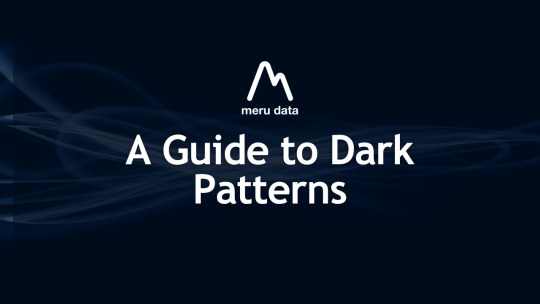
The use of dark patterns have become an increasingly popular practice online. Harry Brignull, who coined the term ‘dark patterns’ defined it as practices that “trick or manipulate users into making choices they would not otherwise have made and that may cause harm.”
The growing popularity of dark patterns has naturally attracted the attention of regulatory bodies. The U.S Federal Trade Commission has even stated that they have been “ramping up enforcement” against companies that employ dark patterns as can be seen with the $520 million imposed on Fortnite creator, Epic Games. In the EU, the fines have been piling up against the violating companies, with TikTok and Facebook facing a €5 million fine and €60 million fine respectively, both imposed by French DPA, the CNIL.
The FTC, in its endeavor to combat the use of dark patterns and protect consumer privacy, even conducted a workshop and released a report on the topic in 2022, titled Bringing Dark Patterns to Light. Samuel Levine, Director of the FTC’s Bureau of Consumer Protection stated, “This report—and our cases—send a clear message that these traps will not be tolerated.” FTC Report Shows Rise in Sophisticated Dark Patterns Designed to Trick and Trap Consumers | Federal Trade Commission
With increasing state privacy regulations in the U.S and given the growing strength of the enforcement around dark patterns, it is important to know the terms that address dark patterns under the existing regulations.
Two significant definitions and regulations of dark patterns within the US come from the California Consumer Privacy Act, CCPA, and the Colorado Privacy Act, CPA. Both these state privacy regulations address dark patterns in a detailed fashion, which can be found below.
Under the CCPA, § 7004. Requirements for Methods for Submitting CCPA Requests and Obtaining Consumer Consent.
Except as expressly allowed by the CCPA and these regulations, businesses shall design and implement methods for submitting CCPA requests and obtaining consumer consent that incorporate the following principles:
“Easy to understand” The language used should be simple and easy to read and comprehend
“Symmetry in choice��. It should be as easy and quick to exercise a more privacy protective option as it is to exercise a less privacy protective option - The process to submit a request to opt-out of sale/sharing of personal information should not require more time than the process to opt-in to the sale of PI after having previously opted out. - “Yes” and “Ask me later” as the ONLY two options to decline the option to opt-in to the sale is not appropriate. “Ask me later” does not imply that the consumer has denied the decision but delayed it. Businesses will continue asking the consumer to opt-in. “Yes” and “No” are the options that should be provided. - “Accept All” and “Preferences” or “Accept All and “More information” as choices to provide consent to the use of consumers personal information is not appropriate as the choice can be accepted in one step but additional steps are required to exercise their rights. “Accept all” and “Decline all” should be used.
Confusing language should be avoided. Consumers choices should be clearly provided. Double negatives should not be used - Confusing options such as the choice of “Yes” or “No” next to the statement “Do Not Sell or Share My Personal Information” is a double negative and should be avoided. - “On” or “off” toggles or buttons may require further clarification - If at first, the options are presented in the order “Yes” and then “No”, it should not be changed then to the opposite order of “No” and then “Yes” as is this unintuitive and confusing.
The design and architecture should not impair the consumers ability to make choices. Consent should be “freely given, specific, informed and unambiguous” - Consumers should not be made to click through disruptive screens before submitting an opt-out request. - The option to consent to using PI for purposes that meet the requirements should not be combined with the option to consent to using PI for purposes that are “incompatible with the context” For example, a business that uses location data for its services such as a mobile app that delivers food to users’ locations should not ask for consent to “incompatible uses” (sale of geolocation data to third parties) along with the “reasonably necessary and proportionate use of geolocation date” that is needed for the apps services. This requires consent to “incompatible uses” to use the apps’ expected services
“Easy to execute”. The process to submit a CCPA request should be straight forward, simple and functional. Consumer’s choice to submit a request should not be undermined - Consumer should not have to search extensively for a privacy policy or webpage for the option to submit an opt-out request after clicking the “Do Not Sell or Share My Personal Information” link. - Businesses that know of faults such as broken links, non-functional email addresses, inboxes that are not monitored, should fix them at the earliest - Consumers should not have to unnecessarily wait on a webpage while the request is being processed.
Using dark patterns (practices stated above) to obtain consent is not considered as consent. Obtaining consent using dark patterns can be considered has having never obtained consumer consent.
Should the user interface unintentionally impair the user’s choice and with this knowledge, the business does not remedy the issue, it could be considered a dark pattern. “Deliberate ignorance” if the faulty, impairing designs may be considered a dark pattern.
Under the CPA, Rule 7.09 USER INTERFACE DESIGN, CHOICE ARCHITECTURE, AND DARK PATTERNS
There should be symmetry in presentation of choices. No one option should be given more focus over others - All options should use the same font, size, and style. “I accept” being in a larger size or in a brighter more attention-grabbing colour over the “I do not accept” is not considered symmetrical. - All choices should be equally easy to accept or reject. The option to “accept all” to consent the use of Sensitive data should be presented without the option to “reject all”
Manipulative language and/or visuals that coerce or steer consumers choices should be avoided - Consumers should not be guilted or shamed into any choice. “I accept. I care about the planet” vs “I reject, I don’t care about the planet” can be considered - “Gratuitous information to emotionally manipulate consumers” should be avoided. Stating that the mobile application “Promotes animal welfare” when asking for consent to collect sensitive data for Targeted Advertising can be considered “deceptively emotionally manipulative” if the reason for collection is not actually critical to promoting animal welfare.
Silence or ‘failure to take an affirmative action’ is not equal to Consent or acceptance - Closing a Consent request pop-up window without first affirmatively making a choice cannot be interpreted as consent. - Going through the webpage without affirmatively providing consent cannot on the banner provided cannot be interpreted as consent. - Using a Smart device without verbal consent; “I accept”, “I consent” cannot be considered affirmative consent.
Avoid preselected or default options - Checkboxes or radial buttons cannot be preselected
It should be as easy and quick to exercise a more privacy protective option as it is to exercise a less privacy protective option. There should be equal number of steps all options - All choices should be presented at the same time. “I accept” and “Learn more” as the two choices presents a greater number of steps for the latter and is an unnecessary restriction. - However, preceding both the “I accept” and “I do not accept” buttons with the “select preferences” button would not be considered an unnecessary restriction.
Consent requests should not unnecessarily interrupt a consumer’s activity on the website, application, product - Repeated consent requests should not appear after the consumer declined consent - Unless consent to process data is strictly necessary, consumers should not be redirected away from their activity if they declined consent - Multiple inconvenient consent request pop-ups should be avoided if they declined consent initially.
“Misleading statements, omissions, affirmative misstatements, or intentionally confusing language to obtain Consent” should be avoided - A false sense of urgency, such as a ticking clock on the consent request should be avoided. - Double negatives should be avoided on the consent request - Confusing language should be avoided such as “Please do not check this box if you wish to Consent to this data use” - Illogical choices like the options of “Yes” or “No” to the question “Do you wish to provide or decline Consent for the described purposes” should be avoided.
Target audience factors and characteristics should be considered - Simplicity of language should be considered for websites or services whose target audience is under the age of 18 - Big size, spacing, and readability should be considered for websites or services whose target audience is elderly people.
User interface design and Consent choice architecture should be similar when accessed through digital accessibility tools - The same number of steps to exercise consent should be provided on the website whether it is accessed using a digital accessibility tool or without.
Going a step further, The Virginia Consumer Data Protection Act, VCDPA, does not specifically address dark patterns. However, the Virginia Attorney General’s office could, in theory, use the regulation’s definition of consent to challenge the use of dark patterns.
The Connecticut Data Privacy Act, CTDPA, defines a Dark Pattern as “a user interface designed or manipulated with the substantial effect of subverting or impairing user autonomy, decision-making or choice”. Any practice the Federal Trade Commission (FTC) deems a "dark pattern" is also included in this definition. It is important to note that Consent obtained through the use of a Dark Pattern is not deemed valid under the CTDPA.
These are some examples of US state regulations around dark patterns. Be sure to review all state privacy laws that affect your business.
For more insights and updates on privacy and data governance, visit Meru Data | Data Privacy & Information Governance Solutions
#data privacy#data security#ai privacy#gdpr#ccpa#artificial intelligence#data protection#internet privacy#dark patterns#cybersecurity#data mapping
0 notes
Text
0 notes
Text



4 more maps in regards to the topic of Mutants. Been quite busy with things though so as far as everything else is concerned there’s nothing else much to tell. It’s rather intricate of a topic, but as far as other things go there’s a lot still needed to be mapped out as far as the eye can see.
#Mutants#mutant mappings#mutarative#Mutants of the world#Mutants mappings of variant#mutants mapping data#Data mapping#mapping#maps of data#maps of mutants#4 maps of mutalitarative
0 notes
Text
The Importance of Data Mapping in the World of Data Science | Infographic
Data management is an important aspect of today’s data-driven businesses and data mapping constitutes an important part of it. The data management industry is growing at a CAGR of 11.2% to reach a market size of $281.9 billion by 2028, and data mapping will have an important role to play.
In simple terms, it refers to the process of creating element mappings between two distinct data models i.e., it ensures that data from a source system is accurately and appropriately translated to a target system that maintains the integrity and consistency of data.
Practically, it defines how individual fields in the source data correspond to fields in the destination data. The entire process can either be straightforward involving direct field-to-field mappings or complex where transformation rules, lookups, and aggregations are required.
For example, in simple mapping “first_name” field in source data is linked to the corresponding field “given_name” in the target database. Whereas in more complex scenarios, it might include linking “first_name” and “last_name” into a single “full_name” field.
Well, data mapping can be quite an interesting skill to learn and it offers several benefits to businesses such as ensuring:
Data quality
Consistency
Integration
Compliance, etc.
If you are interested in a career in data science, knowledge of data mapping is a must. So, check out our detailed infographic on data mapping and its importance in the world of data science now.

0 notes
Text
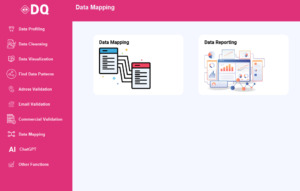
Data validation is a critical aspect of ensuring the accuracy and integrity of data within various systems and processes. It involves the verification and validation of data to guarantee its reliability and usability. Imagine data validation as the gatekeeper that checks every piece of information trying to enter the system, ensuring only the correct and accurate data gets through. Just like a security checkpoint at an airport, data validation filters out the unwanted and potentially harmful data, allowing only the safe and valid data to pass through.
One of the key challenges in data validation is the sheer volume of data that needs to be processed. With the exponential growth of data in today's digital age, manual validation processes are no longer feasible. This is where automated data validation tools and techniques come into play. These tools streamline the validation process, making it faster, more efficient, and less prone to human error. It's like having a team of tireless workers who meticulously examine every piece of data, ensuring its accuracy and quality without getting tired or making mistakes.
Ensuring data accuracy is not just about maintaining the quality of information but also about upholding the credibility and trustworthiness of the entire system. Inaccurate data can lead to faulty decisions, flawed analysis, and ultimately, disastrous outcomes. Just like a single wrong turn can lead to getting lost in a maze, one incorrect piece of data can derail an entire process or system. Data validation acts as a compass, guiding the system in the right direction by ensuring that the data it relies on is accurate, reliable, and consistent.
Data validation is not a one-time task but an ongoing process that requires continuous monitoring and maintenance. As data evolves and changes over time, so do the validation requirements. Regular data validation checks are essential to identify and rectify any discrepancies, anomalies, or errors in the data. It's like regularly servicing your car to ensure it runs smoothly and efficiently. By proactively validating data on a regular basis, organizations can prevent data quality issues before they escalate into major problems.
0 notes
Text
Revolutionizing Revenue Recognition: The Power of Automation
The answer lies in automating the decision-making process itself.
Revenue accounting automation involves pre-defining rules based on policies and desired outcomes. These rules can then be applied directly to data sourced from sales contracts and various systems capturing orders, fulfillment, and billing. The result? Precise revenue calculations and forecast schedules over the contract term.
So, how does it actually work?
Imagine a revenue analyst reviewing a contract to identify critical components for revenue recognition. Similarly, automation software can be configured to identify these components through data mapping—things like contract number, customer name, contract term, deliverables, and pricing details.
Instead of relying on cumbersome spreadsheets, an automated revenue sub-ledger takes on the task of aggregating data, applying rules, and recognizing revenue based on predefined criteria.
Think of it as building a roadmap for revenue recognition—a set of rules and guidelines that automate the process from start to finish.
#Revenue Recognition#Automation#Accounting Automation#Revenue Accounting#Decision-Making Automation#Contract Management#Data Mapping#Forecasting#Rules-Based Automation#Financial Software
0 notes
Text
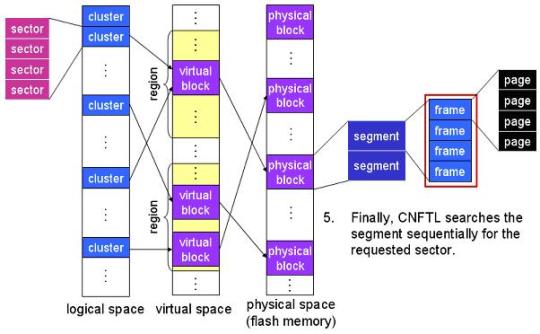
#credit:Flashlab#data mapping#segment#virtual space#logical space#physical space#flash memory#sector#hardware to software#address space#address mapping#hardware#software
0 notes
Text
Cartografías de Agua / Río Limarí
Ejercicio realizado para taller de arquitectura.
Realizado junto a Pablo Martínez K.
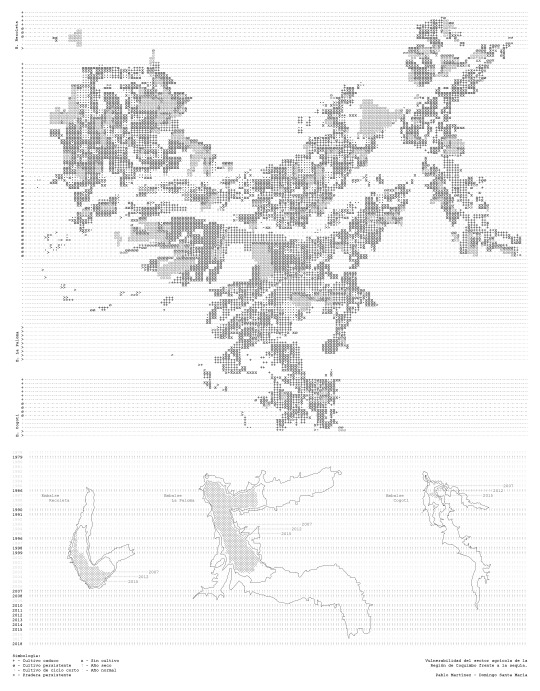
Provincia de Limarí, Región de Coquimbo, Chile / Septiembre 2019
0 notes
Text



Lidar-Derived Aerial Maps Reveal the Dramatic Meandering Changes in River Banks Over Millennia
5K notes
·
View notes
Text



Smart-ass
#Daforge#Data Soong#Geordi La Forge#Star Trek: TNG#TNG#giddly’s art#Yeah. I hit it with the gradient map + glow + chromatic aberration + noise combo#I am not immune to the lazy man’s instant finisher starter pack
234 notes
·
View notes
Text
Transgender Friendly States
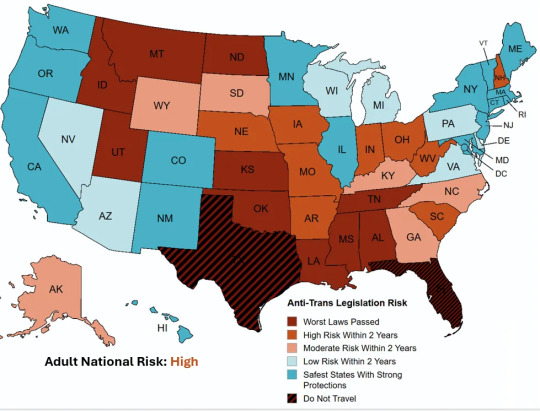
This is a map made by journalist Erin Reed (https://www.erininthemorning.com/). It shows the legislative risk to trans people by state. It's been going around tumblr recently, and for good reason.
I wanted to make a post comparing the type of information you might need if you're considering making a move following the election. The following includes the cost of living index, the climate risk, the median rent, the minimum wage, and the shift in voting pattern between the 2020 and 2024 election for each "Safest States with Strong Protections" (dark blue on map above).
State: California
*Cost of Living: 134.5% of US average
Climate Risk: Moderate
Median Rent: $1,856
Minimum Wage: $16/hr (116 hours to make rent)
2020vs2024 Politics: Blue, went 8 points redder
State: Colorado
*Cost of Living: 105.5% of US average
Climate Risk: Low
Median Rent: $1,594
Minimum Wage: $14.42/hr (110.5 hours to make rent)
2020vs2024 Politics: Blue, went 2 points redder
State: Connecticut
*Cost of Living: 113.1% of US average
Climate Risk: Low
Median Rent: $1,374
Minimum Wage: $15.69 (87.5 hours to make rent)
2020vs2024 Politics: Blue, went 5 points redder
State: Illinois
*Cost of Living: 90.8% of US average
Climate Risk: Moderate
Median Rent: $1,179
Minimum Wage: $14/hr (84 hours to make rent)
2020vs2024 Politics: Blue, went 7 points redder
State: Hawaii
*Cost of Living: 179% of US average
Climate Risk: Low
Median Rent: $1,868
Minimum Wage: $14/hr (133 hours to make rent)
2020vs2024 Politics: Blue, went 6 points redder
State: Maine
*Cost of Living: 111.5% of US average
Climate Risk: Low
Median Rent: $1,009
Minimum Wage: $14.15/hr (71 hours to make rent)
2020vs2024 Politics: Blue, went 2 points redder
State: Maryland
*Cost of Living: 119.5% of US average
Climate Risk: Low
Median Rent: $1,598
Minimum Wage: $15/hr (106 hours to make rent)
2020vs2024 Politics: Blue, went 6 points redder
State: Massachusetts
*Cost of Living: 148.4% of US average
Climate Risk: Moderate
Median Rent: $1,588
Minimum Wage: $15/hr (106 hours to make rent)
2020vs2024 Politics: Blue, went 8 points redder
State: Minnesota
*Cost of Living: 94.1% of US average
Climate Risk: Low
Median Rent: $1,178
Minimum Wage: $10.85/hr (108 hours to make rent)
2020vs2024 Politics: Blue, went 3 points redder
State: New Jersey
*Cost of Living: 114.1% of US average
Climate Risk: Moderate
Median Rent: $1,577
Minimum Wage: $15.13/hr (104 hours to make rent)
2020vs2024 Politics: Blue, went 10 points redder
State: New Mexico
*Cost of Living: 94.2% of US average
Climate Risk: High
Median Rent: $966
Minimum Wage: $12/hr (80.5 hours to make rent)
2020vs2024 Politics: Blue, went 5 points redder
State: New York
*Cost of Living: 125.1% of US average
Climate Risk: Moderate
Median Rent: $1,507
Minimum Wage: $15/hr (16/hr for NYC, Long Island, and Westchester), (100.5 hours to make rent)
2020vs2024 Politics: Blue, went 11 points redder
State: Oregon
*Cost of Living: 115.1% of US average
Climate Risk: Low
Median Rent: $1,373
Minimum Wage: $16.70/hr (but it's complicated) (82 hours to make rent)
2020vs2024 Politics: Blue, went 2 points redder
State: Rhode Island
*Cost of Living: 110.5% of US average
Climate Risk: Moderate
Median Rent: $1,195
Minimum Wage: $14/hr (85 hours to make rent)
2020vs2024 Politics: Blue, went 7 points redder
State: Vermont
*Cost of Living: 114.9% of US average
Climate Risk: Low
Median Rent: $1,149
Minimum Wage: $13.67 (84 hours to make rent)
2020vs2024 Politics: Blue, went 3 points redder
State: Washington
*Cost of Living: 115.1% of US average
Climate Risk: Low
Median Rent: $1,592
Minimum Wage: $16.28 (97 hours to make rent)
2020vs2024 Politics: Blue, went 0 points redder
*On this scale, 100% is the average COL across the USA. Numbers above 100% mean the state is more expensive than average. Numbers below 100% mean the state is less expensive to live in than average. Pennsylvania, Utah, and Nevada are the states closest to average. Hawaii, at 179% is the most expensive state. Mississippi, at 85.3% is the least expensive state to live in.
References: COL CR MR MW POL
168 notes
·
View notes
Text
So there is a post going around with a realy suspicious map, and OP of the post has me blocked so here is a link to their post since I cannot reblog it.
Okay so, I looked into this as from my own experience the map looked suspicious.
The orignal post of the map has been deleted. You can find the deleted post on reddit about it here.
I managed to find a repost of the map on tumblr, which had linked to the deleted reddit post, and you can find the repost of the orignal map here. Now onto debunking OP's claim of the map.
The title of the map is not solely about the west bank, it is about full john oliver episodes being unavailable in countries. Not just the west bank episode, all full episodes.
When I try to watch the video, i get the below error from youtube
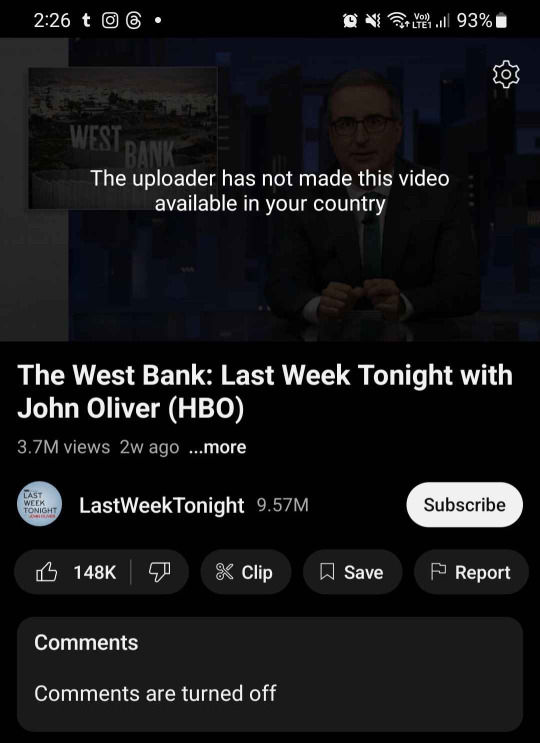
Yep your eyes do see correctly. It is the uploader who made it unavailable. This means that either John Oliver himself, his production team or HBO who has the rights to his show, decided to make his content not available to be viewed in certain countries.
A comment on the reddit post which I think people should read is
"The title of this post makes many people think OP means ‘countries that have banned this’. Instead, this is just ‘countries where a network pays for the broadcast rights for this show’. The highlighted countries are ones where the show is most popular. The blank countries are where it’s not popular, so they give it away for free to try to drum up support"
Aka this is not purposeful censorship by (((zionists)) like tumblr op is trying to frame it. Its not keeping what happens in the west bank a secret. It is a decision made by someone in charge of the show, to make as much money as possible. Which still sucks! But, it sucks for different reasons than what tumblr OP is alluding to.
3. Tumblr OP is being antisemitic. Whilst it is definately written in a more subtle way, it is still invoking the whole "jews control the media" trope. A well known antisemitic trope is still antisemitic even if "jew" is replaced with "zionist". This is because whilst not every use of "zionist" is a proxy word of jew, it happens more than you think, to the point where meta (instagram and facebook) updated their hate speech policy to puroposefully include "zionist when its being used as proxy (aka dogwhistle) for jew is now hate speech on our platform". Meta still allows it to be used when talking about zionism as a political ideology, and have only banned the use of it as a proxy for jew.
OP of this post has already blocked me (only found out when i saw this post), so I wanna thank @coffeeconcentrate for reblogging this and not having me blocked so I can actually have a chance at reaching even a small group of people to make them aware of this so they don't fall for this poorly made post.
#whenever you see a map or graph which lacks both of those 9/10 its because the data doesn't fit the narrative they're trying to push#antisemitism#jumblr#jewblr#disinformation
200 notes
·
View notes
Text

New Data File Alert! We're taking a look at Sonic's backyard - the Acorn Territories! Pencils by SJG, Inks and Colors by Pichi.
https://archiesoniconline.com/?page_id=29417
56 notes
·
View notes